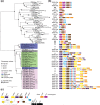Comparative analysis of integrative and conjugative mobile genetic elements in the genus Mesorhizobium
- PMID: 34605762
- PMCID: PMC8627217
- DOI: 10.1099/mgen.0.000657
Comparative analysis of integrative and conjugative mobile genetic elements in the genus Mesorhizobium
Abstract
Members of the Mesorhizobium genus are soil bacteria that often form nitrogen-fixing symbioses with legumes. Most characterised Mesorhizobium spp. genomes are ~8 Mb in size and harbour extensive pangenomes including large integrative and conjugative elements (ICEs) carrying genes required for symbiosis (ICESyms). Here, we document and compare the conjugative mobilome of 41 complete Mesorhizobium genomes. We delineated 56 ICEs and 24 integrative and mobilizable elements (IMEs) collectively occupying 16 distinct integration sites, along with 24 plasmids. We also demonstrated horizontal transfer of the largest (853,775 bp) documented ICE, the tripartite ICEMspSymAA22. The conjugation systems of all identified ICEs and several plasmids were related to those of the paradigm ICESym ICEMlSymR7A, with each carrying conserved genes for conjugative pilus formation (trb), excision (rdfS), DNA transfer (rlxS) and regulation (fseA). ICESyms have likely evolved from a common ancestor, despite occupying a variety of distinct integration sites and specifying symbiosis with diverse legumes. We found extensive evidence for recombination between ICEs and particularly ICESyms, which all uniquely lack the conjugation entry-exclusion factor gene trbK. Frequent duplication, replacement and pseudogenization of genes for quorum-sensing-mediated activation and antiactivation of ICE transfer suggests ICE transfer regulation is constantly evolving. Pangenome-wide association analysis of the ICE identified genes potentially involved in symbiosis, rhizosphere colonisation and/or adaptation to distinct legume hosts. In summary, the Mesorhizobium genus has accumulated a large and dynamic pangenome that evolves through ongoing horizontal gene transfer of large conjugative elements related to ICEMlSymR7A.
Keywords: ICE; IME; bacterial evolution; conjugation; integrase; integrative and conjugative elements; legumes; mobilization; recombinase; symbiosis; tripartite ICE.
Conflict of interest statement
The authors declare that there are no conflicts of interest.
Figures




Similar articles
-
Evolutionary persistence of tripartite integrative and conjugative elements.Plasmid. 2017 Jul;92:30-36. doi: 10.1016/j.plasmid.2017.06.001. Epub 2017 Jun 29. Plasmid. 2017. PMID: 28669811 Review.
-
Population genomics of Australian indigenous Mesorhizobium reveals diverse nonsymbiotic genospecies capable of nitrogen-fixing symbioses following horizontal gene transfer.Microb Genom. 2023 Jan;9(1):mgen000918. doi: 10.1099/mgen.0.000918. Microb Genom. 2023. PMID: 36748564 Free PMC article.
-
Assembly and transfer of tripartite integrative and conjugative genetic elements.Proc Natl Acad Sci U S A. 2016 Oct 25;113(43):12268-12273. doi: 10.1073/pnas.1613358113. Epub 2016 Oct 12. Proc Natl Acad Sci U S A. 2016. PMID: 27733511 Free PMC article.
-
Ribosomal frameshifting and dual-target antiactivation restrict quorum-sensing-activated transfer of a mobile genetic element.Proc Natl Acad Sci U S A. 2015 Mar 31;112(13):4104-9. doi: 10.1073/pnas.1501574112. Epub 2015 Mar 18. Proc Natl Acad Sci U S A. 2015. PMID: 25787256 Free PMC article.
-
Regulation of conjugative transfer of plasmids and integrative conjugative elements.Plasmid. 2017 May;91:82-89. doi: 10.1016/j.plasmid.2017.04.002. Epub 2017 Apr 22. Plasmid. 2017. PMID: 28438469 Review.
Cited by
-
Investigation of genomic island 2 deciphers the evolution of a genus Brucella.Sci Rep. 2025 Jun 6;15(1):19877. doi: 10.1038/s41598-025-05244-1. Sci Rep. 2025. PMID: 40481250 Free PMC article.
-
An epigenetic switch activates bacterial quorum sensing and horizontal transfer of an integrative and conjugative element.Nucleic Acids Res. 2022 Jan 25;50(2):975-988. doi: 10.1093/nar/gkab1217. Nucleic Acids Res. 2022. PMID: 34904658 Free PMC article.
-
Closed genomes of commercial inoculant rhizobia provide a blueprint for management of legume inoculation.Appl Environ Microbiol. 2025 Feb 19;91(2):e0221324. doi: 10.1128/aem.02213-24. Epub 2025 Jan 10. Appl Environ Microbiol. 2025. PMID: 39791879 Free PMC article.
-
Beav: a bacterial genome and mobile element annotation pipeline.mSphere. 2024 Aug 28;9(8):e0020924. doi: 10.1128/msphere.00209-24. Epub 2024 Jul 22. mSphere. 2024. PMID: 39037262 Free PMC article.
-
Comparative genome analysis of Sesbania cannabina-nodulating Rhizobium spp. revealing the symbiotic and transferrable characteristics of symbiosis plasmids.Microb Genom. 2023 May;9(5):mgen001004. doi: 10.1099/mgen.0.001004. Microb Genom. 2023. PMID: 37133904 Free PMC article.
References
-
- Mirkin BG, Fenner TI, Galperin MY, Koonin EV. Algorithms for computing parsimonious evolutionary scenarios for genome evolution, the last universal common ancestor and dominance of horizontal gene transfer in the evolution of prokaryotes. BMC Evol Biol. 2003;3:2. doi: 10.1186/1471-2148-3-2. - DOI - PMC - PubMed
Publication types
MeSH terms
Substances
LinkOut - more resources
Full Text Sources
Miscellaneous

